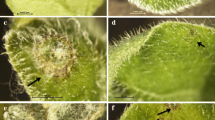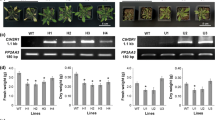Abstract
Gastrodia antifungal proteins (GAFPs) are a group of mannose-binding lectins purified from Gastrodia elata that show strong resistance against a wide spectrum of fungi. The GAFP-2 promoter was analyzed for its ability to control the expression of the reporter gene, β-glucuronidase (GUS) in transgenic tobacco plants. The GUS assays revealed that the GAFP-2 promoter is expressed in a tissue-specific manner, which mainly expressed in the vascular cells. The highest GUS activity was observed in roots, followed by stems. GAFP-2-GUS expression was strongly induced by the fungus Trichoderma viride and by the plant stress regulators, salicylic acid and jasmonic acid in the stably transformed tobacco plants. The −537 region of the GAFP-2 promoter was sufficient for its tissue-specific and inducible expression of the promoter.





Similar content being viewed by others
References
Buchel AS, Molenkamp R, Bol JF, Linthorst HJM (1996) The PR-1a promoter contains a number of elements that bind GT-1-like nuclear factors with different affinity. Plant Mol Biol 30:493–504
Buchel AS, Brederode FT, Bol JF, Linthorst HJM (1999) Mutation of GT-1 binding sites in the Pr-1a promoter influences the level of inducible gene expression in vivo. Plant Mol Biol 40:387–396
Du L, Chen Z (2000) Identification of genes encoding receptor-like protein kinases as possible targets of pathogen- and salicylic acid-induced WRKY DNA-binding proteins in Arabidopsis. Plant J 24:837–847
Eulgem T, Rushton PJ, Schmelzer E, Hahlbrock K, Somssich IE (1999) Early nuclear events in plant defence signaling: rapid gene activation by WRKY transcription factors. EMBO J 18:4689–4699
Fukuda Y (1994) Characterization of a novel cis-acting element that is responsible to a fungal elicitor in the promoter of a tobacco class I chitinase gene. Plant Mol Biol 24:485–493
Green PJ, Kay SA, Chua NH (1987) Sequence-specific interaction of a pea nuclear factor with light-responsive elements upstream of the rbcS-3A gene. EMBO J 6:2543–2549
Hertig C, Rebmann G, Bull J, Mauch F, Dudler R (1991) Sequence and tissue-specific expression of a putative peroxidase gene from wheat (Triticum aestivum L.). Plant Mol Biol 16:171–174
Hu Z, Huang Q (1994) Induction and accumulation of the antifungal protein in Gastrodia elata. Acta Bot Yunnanica 16:169–177
Hu Z, Yang Z, Wang J (1988) Isolation and partial characterization of an antifungal protein from Gastrodia elata corm. Acta Bot Yunnanica 10:373–380
Hu Z, Huang Q, Liu X, Yang J (1999) Primary structure and cDNA cloning of the antifungal protein GAFP-1 from Gastrodia elata. Acta Bot Yunnanica 21:131–138
Jefferson RA (1987) Assaying chimeric genes in plant: the GUS gene fusion system. Plant Mol Biol Rep 5:387–405
Joshi CP (1987) An inspection of the domain between putative TATA box and translation start site in 79 plant genes. Nucleic Acids Res 15:6643–6653
Keller H, Pamboukdjian N, Ponchet M, Poupet A, Delon R, Verrier JL, Roby D, Ricci P (1999) Pathogen-induced elicitin production in transgenic tobacco generates a hypersensitive response and nonspecific disease resistance. Plant Cell 11:223–35
Kim S, Choi J, Costa MA, An G (1992) Identification of G-box sequence as an essential element for methyl jasmonate response of potato proteinase inhibitor II promoter. Plant Physiol 99:627–631
Lam E, Chua NH (1990) GT-1binding site confers light responsive expression in transgenic tobacco. Science 248:471–474
Liu J, Xu J, Wang H, Liu H, Sun Y (1993) Detection and immunofluorescence localization of antifungal protein of Gastrodia elata. Acta Bot Sin 35:593–599
Mason H S, DeWald DB, Mullet JE (1993) Identification of a methyl jasmonate-responsive domain in the soybean vspB promoter. Plant Cell 5:241–251
Menke FLH, Champion A, Kijne JW, Memelink J (1999) A novel jasmonate- and elicitor-responsive element in the periwinkle secondary metabolite biosynthetic gene Str interacts with a jasmonate- and elicitor-inducible AP2-domain transcription factor, ORCA2. EMBO J 18:4455–5563
Murashige T, Skoog F (l962) A revised medium for rapid growth and bioassays with tobacco tissue. Physiol Plant 15:473–497
Reymond P, Farmer EE (1998) Jasmonate and salicylate as global signals for defense gene expression. Curr Opin Plant Biol 1:404–411
Rushton PJ, Torres JT, Parniske M, Wernert P, Hahlbrock K, Somssich IE (1996) Interaction of elicitor-induced DNA-binding proteins with elicitor responsive elements in the promoters of parsley PR1 genes. EMBO J 15:5690–5700
Santamaria M, Thomson CJ, Read ND, Loake GJ (2001) The promoter of a basic PR1-like gene, AtPRB1, from Arabidopsis established an organ-specific expression pattern and responsiveness to ethylene and methyl jasmonate. Plant Mol Biol 47:641–652
Wang X, Bauw G, Van Damme EJM, Peumans WJ, Chen ZL, Van Montagu M, Angenon G, Dillen W (2001) Gastrodianin-like mannose-binding proteins: a novel class of plant proteins with antifungal properties. Plant J 25:651–661
Wang Y, Li W, Lam H, Zhang X, Chen Q, Guo S, Sun Y (2000) N-terminal sequencing and cDNA cloning of Gastrodia antifungal protein (GAFP) from Gastrodia (G. elata Bl f. elata). High Technol Lett 10:10–14
Xu Q, Liu Y, Wang X, Gu H, Chen Z (1998) Purification and characterization of a novel anti-fungal protein from Gastrodia elata. Plant Physiol Biochem 36:899–905
Yang P, Chen C, Wang Z, Fan B, Chen Z (1999) A pathogen- and salicylic acid-induced WRKY DNA-binding activity recognizes the elicitor response element of the tobacco class I chitinase gene promoter. Plant J 18:141–149
Yu D, Chen C, Chen Z (2001) Evidence for an important role of WRKY DNA binding proteins in the regulation of NPR1 gene expression. Plant Cell 13:1527–1540.
Acknowledgements
We thank Dr. Shunxing Guo for the kind gift of Gastrodia elata and Dr. Xihua Du for assistance with the sections and photos. We also thank Dr. Chengcai Chu for the spectrophotometer and Prof. Guenter Kahl and Dr. Jianru Zuo for critical reading of this manuscript. This study was supported by the National Natural Science Foundation of China (grant No. 30270746).
Author information
Authors and Affiliations
Corresponding author
Additional information
Communicated by H.S. Judelson
Rights and permissions
About this article
Cite this article
Sa, Q., Wang, Y., Li, W. et al. The promoter of an antifungal protein gene from Gastrodia elata confers tissue-specific and fungus-inducible expression patterns and responds to both salicylic acid and jasmonic acid. Plant Cell Rep 22, 79–84 (2003). https://doi.org/10.1007/s00299-003-0664-z
Received:
Revised:
Accepted:
Published:
Issue Date:
DOI: https://doi.org/10.1007/s00299-003-0664-z




